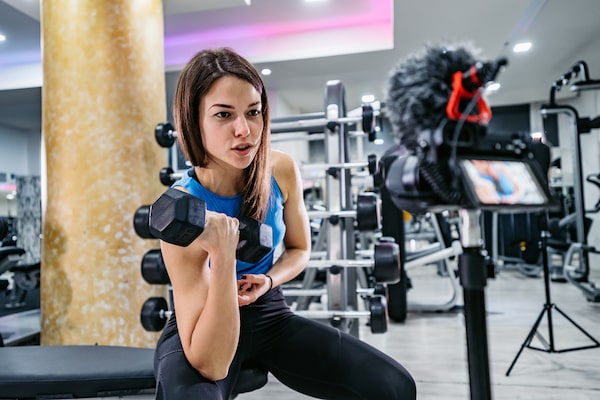
A fitness vlogger is making a video of herself at the gym doing bicep curls.Getty Images/AFP/Getty Images
Joey Swoll may be the most important person working in the fitness industry today. With millions of followers across multiple social-media platforms, the ultra-jacked bodybuilder (they don’t call him “swoll” for nothing) is moderating what has quickly become the most contentious issue in the strength-training world – the use of cameras in the gym.
The self-appointed CEO of a movement he calls “Gym Positivity,” Mr. Swoll has amassed his sizable audience in part by creating good-natured videos in which he dispenses advice on all aspects of fitness etiquette, from wiping down machines to treating gym staff with respect. But it’s by drawing attention to the fairly new phenomenon of lifters who insist on filming every aspect of their workouts that Joey Swoll won my heart.
Unless you frequent big-box gyms or, like me, your social feeds are flooded with wide-eyed fitness “influencers” struggling to establish a foothold in what has to be one of the most oversaturated markets in history, you likely have no idea how bad this situation has become. We’re not talking about simple, unobtrusive videos shot from a handheld perspective; now, content creators are making use of tripods and microphones to give their films a professional sheen, turning already crowded weight rooms around the world into makeshift sound stages.
Needless to say, this encroachment usually leads to gym-bro drama that of course is captured on camera – and sometimes even broadcast live for all the world to see.
What is an influencer anyway?
In order to make sense of what appears to be entirely self-obsessed behaviour, it’s important first to understand influencer culture. Once upon a time a successful business needed to provide somewhat tangible products or services, but smartphones and social media have changed that. The digital marketplace is very real and very lucrative; learn how to manipulate the various algorithms that rule this marketplace and you can make a real living. But in order to do that, you must first create engaging content.
Annoying as this may be to those of us who choose a mostly analog life, the problem with fitness influencers isn’t so much with the filming itself, it’s with what’s going on in the background and outer edges of the camera’s frame, where regular folks are being cast as extras without their consent. When influencers share their films, even if the content has educational value, oftentimes it’s the people minding their own business in the background who get thrust into the spotlight. Comments come rolling in, ridiculing innocent bystanders who might not have the most picture-perfect lifting form or whose bodies don’t conform to whatever absurd standard is in vogue. It’s from these sorts of pile-ons that mean-spirited viral memes are born.
Kids today …
It can be tempting for greybeards like myself to write off this sort of behaviour as vapid kid stuff, but that would be unfair. There are legitimate reasons for filming yourself in the gym, reasons that have nothing to do with enhancing one’s social-media status. Lots of trainers (myself included) make a good portion of their income working with clients through app-based platforms. From time to time I have to make instructional videos, and I often ask these clients to send me brief clips so I can measure their progress and assess their form.
And herein lies the root of the problem.
The reason filming in the gym has become such a nuisance is that there aren’t any rules surrounding the practice. Influencer culture is a fairly new phenomenon. Gym owners and managers, anxious to make up for lost revenue caused by COVID, have been caught off guard by the influx of influencers trying to make it big. Unfortunately the onus is on those beleaguered figureheads to establish guidelines so that there aren’t any questions as to whether filming is appropriate in their facilities.
The new rules
If I were to open a gym today, the rules would be simple: no filming, period, during peak hours (typically the two hours before and after the once-standard 9-to-5 workday). I’d also designate certain areas of the gym to be “influencer friendly” so that anyone who wants to film themselves can do so without worrying about offending others. These steps alone would go a long way to easing tensions among all concerned parties. I imagine it’s just a matter of time until all gyms adopt this sort of framework.
In the meantime, influencers need to start taking personal responsibility. Even if the gym you frequent doesn’t have any explicit rules about filming, take a second or two before you set up and consider your fellow lifters. Ask that person in the squat rack behind you if they mind being in your shot. And if someone happens to walk through the frame while you’re mid-monologue, so what. Calling that person out on social media creates nothing but bad vibes and will very likely put you on Joey Swoll’s hit list.
Paul Landini is a personal trainer and health educator in Kitchener, Ont.